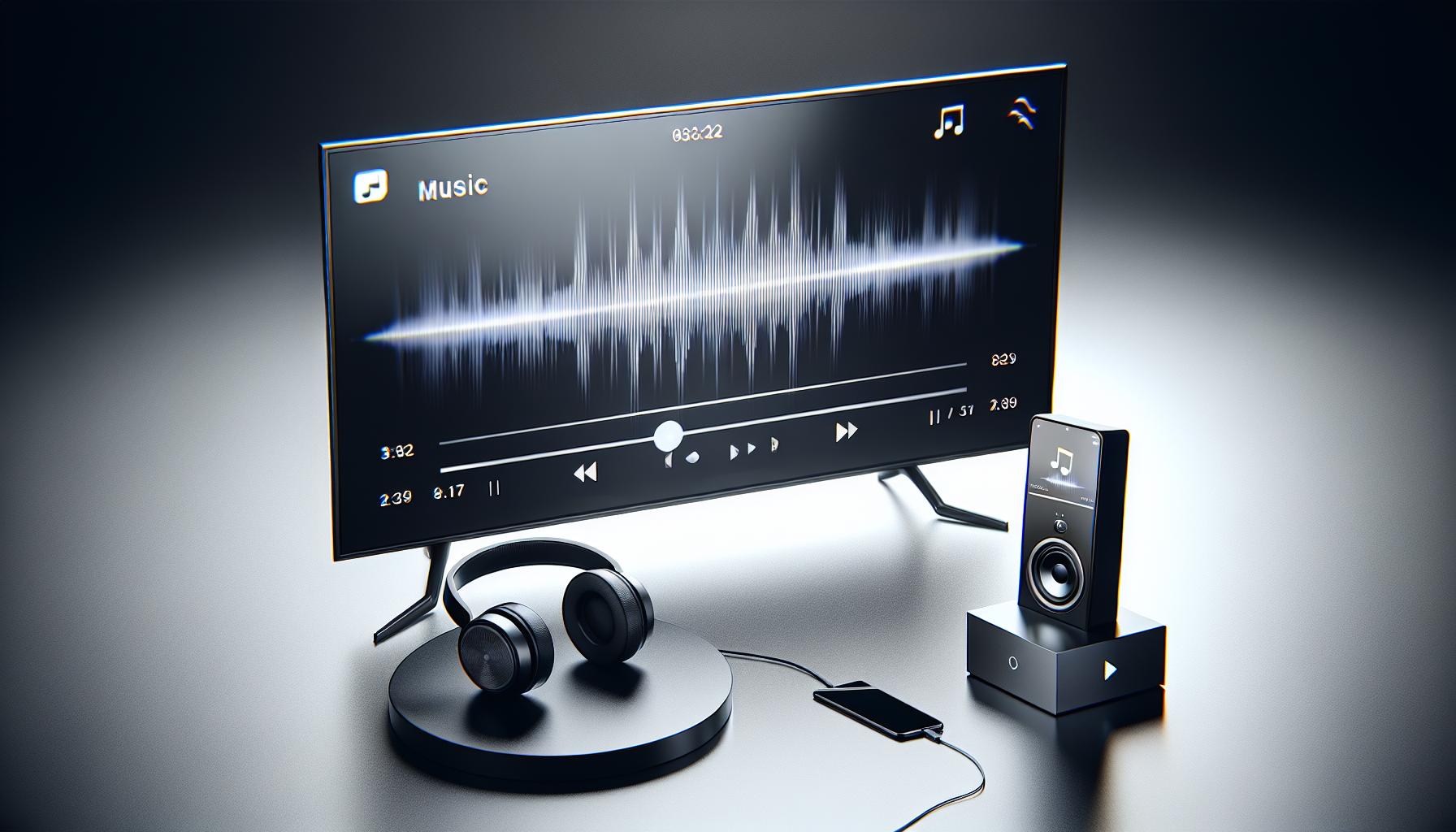Ever wondered how to get your favorite Apple Music playlists booming through your TV speakers? You're not alone. It's a common question for many Apple Music subscribers.
Whether it's for a house party or just a relaxing evening in, playing Apple Music on your TV can seriously upgrade your listening experience. And guess what? It's easier than you might think.
Understanding the basics of Apple Music
Before jumping straight into the step-by-step process of playing Apple Music on your TV, it's essential to understand the basics of Apple Music firstly. Why's that important? Well, the more you know about this service, the more you'll truly appreciate the enhanced music experience on your TV.
Apple Music is a streaming service provided by the tech giant Apple Inc. It's a platform that allows you to enjoy over 90 million songs ad-free, alongside numerous playlists created by the world’s leading music experts. Launched in 2015, it has rapidly grown into one of the most popular music platforms, with millions of subscribers worldwide.
One major perk of Apple Music is its deep integration with Apple's ecosystem. It means if you are an existing Apple device user - be it an iPhone, iPad, Mac, or Apple Watch, you'll have unprecedented access to Apple Music. Plus, it doesn’t stop there! Even if you’re using non-Apple devices such as Android, or smart TVs, you’ll still be able to use this platform. Isn’t this flexibility fantastic?
Next, let’s talk about Apple Music's subscription plans:
| Type | Description | Cost |
|---|---|---|
| Individual | Access for one Apple user | $9.99/month |
| Family | Access for up to six people | $14.99/month |
| Student | Discounted access for eligible college or university students | $4.99/month |
Selecting a plan will depend on your personal or family needs. Whether you want your solo jamming sessions or need family access, there's a plan just right for you!
With all this foundational knowledge about Apple Music, you're perfectly set to move on to the next section - “Getting Started with Apple Music on Your TV.” This upcoming section will give you a detailed guide to help you navigate your music listening experience on the big screen! The idea of blasting your favorite tunes on your TV is exciting, isn’t it?
Exploring different ways to play Apple Music on TV

Now that you're familiar with Apple Music and its diverse offerings, it's time to take the next step: learning how to play your favorite tunes on your TV. This isn't as complex as it may sound, and indeed, there are multiple ways to achieve this.
One of the most straightforward methods is via Apple TV. If you've got an Apple TV device, there's a built-in Apple Music app ready and waiting for you. Signing into your Apple ID lets you access your entire collection instantly.
But what if you don't own an Apple TV? Don't worry, alternative methods exist.
Google Chromecast is one solution. With Apple Music's recent update, Chromecast support is now part of the package. If you have a Chromecast, it's just a matter of linking your Apple Music app. Once connected, your music is only a tap away.
Are you a gamer? Then, you'll love the next option: gaming consoles. PlayStation 4 and Xbox One are more than gaming machines: they're multimedia hubs. With the right app, these consoles can double as music stations.
Smart TVs with an AirPlay feature are another great option. Many Smart TV models boast AirPlay support, allowing you to stream music directly from your iPhone or Mac.
Finally, another solution lies in Bluetooth-enabled TVs. If your TV has Bluetooth, you can pair your iPhone or iPad and listen to Apple Music that way.
Each option has its advantages, and the choice depends on your specific needs and what devices you have at your disposal. The good news is that there are plenty of ways to enjoy Apple Music on a bigger screen. Your perfect music listening setup is closer than you think. You just need to explore these methods and find the one that best suits you.
Next, we'll go through a step-by-step guide on how to use each of these methods. With patience and some basic tech understanding, you'll be streaming your favorite tracks on your TV in no time.
Using an Apple TV to stream Apple Music
You're probably well aware that Apple TV is one of the most straightforward methods to get Apple Music onto your television. The streamer is built to seamlessly integrate Apple's ecosystem, which naturally includes Apple Music. So, you can effortlessly access your entire library from the comfort of your couch.
The process hardly takes any time. You'll first need to make sure your Apple TV is properly set up and connected to the WiFi. Once connected, you simply navigate to the Apple Music app installed on your Apple TV. Now you're ready to sign in using your Apple ID and stream the music you love loud and clear through your television's speakers.
On the Apple Music app, you can immediately use a multitude of features:
- Search: Type out the name of your favorite song, album, or artist using your Apple TV remote.
- For You: This section suggests music based on your listening habits.
- Browse: Scour through new music, playlists, top charts, and genres.
- Radio: Tune in to your preferred station or start a new one from a song or artist you fancy.
There's also the innovative Siri function, which can help if you have your hands full. Request Siri to play a particular song, shuffle your favorite playlist, or even ask for a new recommendation—all by using voice commands.
Apple TV allows a free-flowing interaction with an intuitive interface and crisp audio quality guaranteed to elevate every listening session. It's an excellent way to utilize your Apple Music subscription.
Did you know streaming Apple Music through an Apple TV also gives you access to the lyrics feature? Now, you can jam along to your favourite tunes while also reading the lyrics.
The next section will build upon this, providing you with steps explaining how to navigate your way around the Apple Music app interface on your Apple TV.
Connecting your TV to your iPhone or iPad
To take full advantage of Apple Music's multi-device functionality, you'll need to connect your iPhone or iPad to your TV. Achieving this connectivity broadens your listening experience, transforming your personal Apple Music ecosystem from a one-device activity to an immersive, all-device auditory adventure.
So how do you make this connection possible?
First off, if you're using an Apple TV, make sure the same Apple ID is used on both your Apple TV and your iOS device. This is fundamentally important for achieving an effective and seamless connection between your devices.
After ensuring this, turn on your Apple TV and navigate to the Apple Music app. On your iOS device, head to the settings and select the AirPlay option. AirPlay is the proprietary protocol stack/suite developed by Apple. It allows wireless streaming between devices of audio, video, device screens, and photos.
Select your Apple TV from the audio destinations. Once you've done this, any music or other audio you play on your iPhone or iPad will be mirrored on your TV via Apple TV.
But what if you're using a regular smart TV instead of Apple TV?
Don't fret, you can still connect your iOS device to your TV using Apple's Digital AV Adapter or via a third-party app that supports AirPlay. When using the AV Adapter, simply connect it to your TV via an HDMI cable. Now, join end of the adapter into the lightning port of your iOS device. With this physical connection established, audio content, including Apple Music, can be mirrored from your iOS device to your TV screen.
By following these steps, you're well on your way to expanding your Apple Music listening experience. The subsequent segments will provide a comprehensive walkthrough on maneuvering the interface of the Apple Music app on your TV screen.
Using AirPlay to play Apple Music on TV

Are you wondering how to amplify your Apple Music listening experience? Imagine playing your favorite playlist through a full speaker system while sitting comfortably on your couch. Sounds heavenly, doesn't it?
Well, it's possible! With Apple's AirPlay, you can stream Apple Music directly from your iPhone, iPad, or Mac to your TV, using an Apple TV or some smart TVs that support AirPlay. This process is simple and enhances your music experience drastically!
Mastering this technique significantly ratchets up your entertainment. AirPlay is a proprietary protocol stack developed by Apple that allows wireless streaming of audio, video, and photos, between devices. It's a cool feature that makes it seamless to play Apple Music on TV.
Start by making sure the devices you are using support AirPlay. Most devices made by Apple in the past decade do. Also, ensure that every device is connected to the same Wi-Fi network.
The steps are pretty simple:
- Open Apple Music on your iPhone, iPad, or Mac.
- Select your chosen song, album, or playlist and start playing.
- Tap the AirPlay icon at the bottom of the screen. It looks like a triangle pointing into a circle.
- Choose your TV on the pop-up list.
Guess what? Your favorite tune should now be booming out of your TV's speakers! It's that straightforward. You'll enjoy an unmatched blend of high-quality sound and visual representation of songs, album art, and lyrics on a larger display.
Using AirPlay to play Apple Music on TV not only appeals to sight and sound, it delivers an experience, setting a mood that speakers attached to your Mac, iPhone, or iPad simply can't. Resultantly, your living room becomes a concert hall at a moment's notice.
Don't stop here! There's so much more to learn about utilizing Apple Music for your entertainment. Be prepared for the next section, where we'll delve deeper into other incredible features of Apple Music.
Conclusion
So, you've learned how to play Apple Music on your TV. It's as simple as using AirPlay to stream directly from your iPhone, iPad, or Mac. This new knowledge opens up a world of musical possibilities, transforming your TV into a powerful audio system. With Apple's vast library of over 90 million songs and expertly curated playlists, there's no shortage of tunes to enjoy. Remember, the deep integration of Apple Music within Apple's ecosystem means you can access your favorite tracks on various devices. So, whether you're hosting a party or just relaxing at home, your TV can now deliver a high-quality music experience. Stay tuned for more insights into the incredible features of Apple Music.
What is Apple Music?
Apple Music is a popular streaming service that provides access to over 90 million songs and playlists curated by music experts, offering limitless music discovery opportunities to its subscribers.
How does Apple Music integrate with Apple's ecosystem?
Apple Music deeply integrates with Apple's ecosystem, allowing access on a variety of devices such as iPhones, iPads, Macs, Apple Watches, and HomePods.
What are the subscription plans available for Apple Music?
Apple Music offers various subscription plans, including Student, Individual, and Family plans. Pricing and inclusions can vary, adding to the platform's flexibility to cater to different user needs.
Can I stream Apple Music to my TV? If so, how?
Yes, you can stream Apple Music directly to your TV using the AirPlay feature. By following some easy steps on your iPhone, iPad, or Mac, you can enjoy listening to Apple Music on your TV.
What are the other features of Apple Music?
Apart from basic streaming, Apple Music also offers features like offline listening, personalized music recommendations, real-time lyrics, and more. Further details will be covered in the next section of the article.




